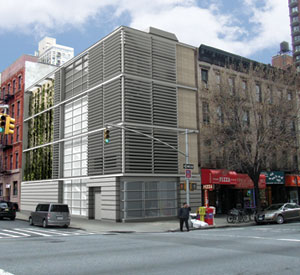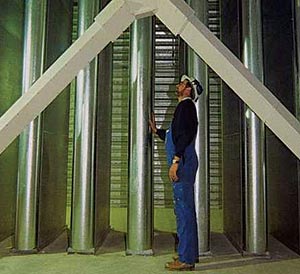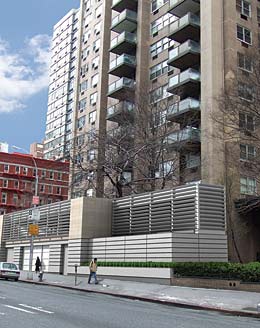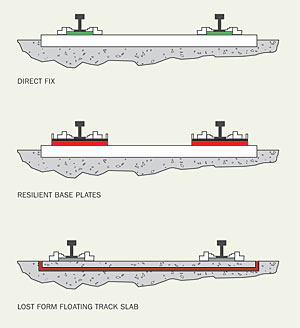Miracle on (and Under) Second Avenue
Architecture goes underground
While the tunnels are the conduits for transit services, they are also permanent volumes that define and confine the limits of the architectural and engineering efforts. Tunnel construction techniques yield two basic profiles for the station volumes-vaulted spaces created by the circular motions of the TBMs, and rectangular ones defined by the cut-and-cover method's soil-supporting slurry walls.
DMJM Harris, the architectural arm of the joint venture, has devised modular, transparent canopies at street level to define entrances, provide shelter, and create an openness to contradict the reality of descending into a cavern. Skylights will penetrate sidewalks, wherever feasible, to invite sunlight as far into mezzanines and platforms as possible. The subterranean experience will be enhanced by other factors, including way-finding strategies, temperature control, lighting, and acoustics.
Acoustical integration is arguably the most challenging aspect of transit design. Sound has multiple air- and ground-borne sources-ambient crowd noise, public address announcements, mechanical noise, and track vibrations. Most of the attenuation and mitigation options involve intense architectural and engineering collaboration. "It's a totally integrated process," explains Kenneth Griffin, AIA, DMJM Harris's chief architect for the project. Griffin's team is designing the line's 16 new subway stations and several ancillary structures and is working closely with all the consultants. "We influence each other's strategies," he says.
|
||||||
For example, FEIS criteria calls for "comfortable and controlled aural environments," in which public address announcements are clearly intelligible. Acoustical engineers from Arup collaborated with the architects and NYCT communications engineers to investigate integrated options. Arup measured the acoustical conditions at existing stations to determine how current public-address systems work and assess the effectiveness of sound-absorbing finishes. They analyzed each link in the chain of sound transmission from the announcer's booth through the cabling infrastructure to the speakers and finally to station platforms, determining that the distortion that so often renders announcements unintelligible is cumulative. Back in Arup's in-house sound lab [record, March 2003, page 149], every factor that either improves or degrades the quality of sound is isolated and evaluated independently, so that the system can be designed and specified as a whole rather the sum of its parts.
To help control reverberant noise from the public-address system, Arup is recommending that the mezzanine and platform ceilings include sound-absorbing elements that are merged with the station architecture. "The effectiveness of sound-absorbing materials depends not only on how much sound they absorb, but also on where the materials are located relative to the noise source," explains Arup acoustical engineer Joe Solway.
The SAS public address system, currently in design development, will include a component for delivering verbal instructions in case of emergency, thus eliminating the less-effective alarm system in use at existing stations. With full-scale mock-ups, the architects are now exploring platform-edge and mezzanine-level "service carriers" that would house the system, along with lighting, closed-circuit TV cameras, and cabling, into canopies. These overhead elements will allow contractors to avoid embedding electrical conduit in concrete, thus keeping this critical station infrastructure accessible for maintenance, explains Griffin.
In all aspects of design development, the architects are guided by 12 design principles that consider the interface between architecture and the myriad engineering, life-safety, and urban-design requirements. For instance, one of the design principles calls for a balance between station context and essential "elements of continuity." These are "the physical elements that have a systemwide reference." They are standard planning devices, such as structural grids and modular components, which can be repeated in all the stations to a degree that is practical. Whereas continuity is important to passenger orientation and comfort, it is critical to maintaining structures that are designed and built to perform well for 100 years. Building services, systems, lighting, and graphics must be integrated identically in each station, and the repetition of modular components allows efficient repair and replacement. The office walls of the DMJM Harris/Arup joint venture are plastered with studies showing this integration and design evolution to date.
In addition to the new subway stations, DMJM Harris is designing several ancillary, multistoried structures at street level, which will house exhaust fans and other ventilation equipment serving individual stations and tunnels. The acoustical and mechanical engineers are working to ensure that fans, cooling towers, and handling units are designed with the necessary sound attenuation to reduce noise emission to the exterior and surrounding buildings. These measures become architectural concerns because the mitigation strategies can affect material choice and facade design. As preliminary renderings show, these unoccupied structures will receive the same level of architectural detailing as the subway stations, since their presence will similarly define the surrounding urban fabric.
Sudhir Jambhekar, AIA, principal at New York City−based FXFOWLE Architects, worked on the SAS for three years. Although the firm is no longer involved, the experience led Jambhekar to develop an argument regarding the architect's role in large infrastructure projects, such as the SAS. "Architects assume that there isn't much design opportunity in these building types, but that's just not the case," he insists.
Jambhekar acknowledges that organizational and management hierarchies can be more complicated than those applied to comparable commissions, such as highly specialized institutional projects. Infrastructure projects can take two or three times longer to complete, requiring a commitment of a decade or longer. Architects often work within large teams, which, in addition to the typical consultants, can include a maze of government agencies and regulatory commissions. However, in spite of these challenges, he makes a strong case for architects' involvement: "Infrastructure influences quality-of-life issues more than people think, which is why we should feel obligated to participate."












